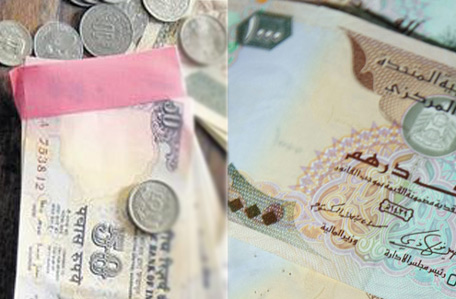The Indian rupee fell to another record low against the US dollar (and dollar-denominated currencies like the UAE dirham and Saudi riyal) this morning as last week’s positive US data continues to boost the greenback.
The rupee hit Rs16.646 against one UAE dirham (Rs61.14 vs. $1) at 8.10am UAE time (04:10GMT), moving past last Friday’s low of Rs16.633 vs. Dh1 (Rs61.09 vs. $1) as Indian importers continue to buy dollars to meet growing demand.
The forex markets reopened today after their weekend break, and the rupee once again tumbled at the opening bell, signaling a loss of faith among foreign investors in the rupee, coupled with a renewal in the US dollar’s strength.
According to market players, bond yields also jumped as foreign investors continue to exit rupee debt. India’s benchmark stock index BSE Sensex was down more than 200 points (1.1 per cent) at 19,279 at 10.50am UAE time, while Nifty was down 71 points (1.2 per cent) to 5,797 points.
A report by HDFC Securities, the brokerage arm of India’s HDFC Bank, pegs the rupee’s upper resistance level for the next two months at Rs63 vs. $1, suggesting that if things don’t improve soon, the Indian rupee could hit Rs17.15 against the UAE dirham within the next 60 days.
Considering that the rupee traded at Rs14.08 vs. Dh1 on October 5, 2012, a slump to Rs17.15 for Dh1 would amount to a decline of almost 22 per cent in less than a year. The rupee is already down 11.3 per cent in the first six months or so of 2013, and the rest of the year doesn’t look too bright for it either.
Indian expats, however, aren’t complaining, as they are getting the most buck from their dirhams, dollars and dinars at the remittance counters. Still, a section of non-resident Indians (NRIs) do believe that with the rupee losing its floor, their dependents in India will need to spend more rupees for everything that they consume, from fuel to food, which will again put pressure on those remitting money.
A fall in the value of the Indian rupee means that Indians in India need to spend more per unit of imported goods, including petrol, fertilisers, and food staples such as pulses, leading to higher inflation. A fuel-price hike (Indian government raised the price of petrol three times last month) in any case translates into a hike in most goods that need to be transported, as well as services.


